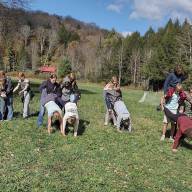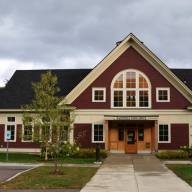By Yawu Miller
Photo: The Bates sisters in Fayston in the 1976: Grace, Diana and Bess. The author Yawu Miller is the boy on the right.
A note from Mary Kathleen Mehuron:
It has been four and half years since I started the Take Me Back project and nonprofit, hopefully planting seeds of trust in the garden that is our most historic families. When I saw this article by the author and editor in my inbox I broke out in goosebumps. Yawu is the cousin of Valley resident Gamal Buhaina.
It was late afternoon when the storm clouds darkened the Mount Ellen ridgeline bringing with them the threat of a torrential summer thunder shower.
“We gotta get the hay in the barn!” Dean Cameron shouted to young Grace Bates, as he urged on a pair of draught horses pulling a wagon laden with fresh-cut hay. Gracie watched on as the horses struggled up German Flats Road from the hay fields down their road, their light brown manes flowing with gathering winds as the thunder clouds bore down on the narrow valley.
The wild scene was etched vividly into 12-year-old Gracie’s memory, an unforgettable memory from 1952 in the Mad River Valley. Grace’s mother, Amelie Bates, had died the year before. Her father Johnny Bates had brought Grace and two sisters – 16-year-old Joan and 14-year-old Diana – to the family’s farm not a mile down German Flats Road from Dean and Mabel Cameron’s farm, hoping to get the girls away from the noise of the city.
But after Joan broke her leg when she fell from a swing, Johnny took three of his daughters back to the city where Joan would better recuperate, leaving Grace to spend the summer with the Cameron family.
HOMESTEAD FOR BATES GIRLS
Since Amelie’s father, Raphael Welles Pumpelly in 1939 purchased farmland and a modest, aging farmhouse from the Cameron family, the Mad River Valley has served as a homestead for the Bates girls, with all of them having taken up residence at the home on German Flats Road at one point. Diana and Bess had the longest tenures in The Valley, raising children in Fayston and Waitsfield. Amelie’s mother, Amelia (Ripley) Pumpelly, had family in Vermont going back to the late 1700s when the Young and Ripley families settled in Middlebury.
The Ripley family later settled in Rutland, running a successful marble company and bank there. By the 1930s, the Ripley descendants had left Vermont, but Amelie and her brother Ripley Pumpelly moved back, with Ripley settling in Mendon, then Pomfret. For Amelie and Johnny, the German Flats Road farm was the perfect summer escape – a narrow dirt road where auto traffic on most days was limited to the postal truck. Guests from New York City included writer Ralph Ellison, who began his great American novel “Invisible Man” in the barn across the road from the farmhouse. He may well have completed it there, were it not for naughty Diana and Joan, who continually threw rocks at the barn, eventually driving Ellison away from Fayston.
Grace’s summer with the Camerons was a welcome respite amid a challenging time. She fondly recalls the sheer terror she experienced descending the narrow, rutted dirt road that ran from German Flats Road to Route 100 (Before the advent of the Sugarbush Access Road) in Cameron’s 1920s-era jalopy.
Her summer in the Cameron household was emblematic of Vermont life at the time. Electrification wouldn’t come that far up German Flats Road until the late 50s. The Camerons lit their homes with kerosene lamps, pumped water from the well by hand, cooked on a wood stove and relied on a large outhouse for waste disposal. When Dean’s horses weren’t hauling hay, he put them to work hauling logs from the forests in the Slide Brook valley. Like many Vermonters in those days, he got by as best he could. Grace recalls rolling cigarettes with Cameron at a table in his living room. Store-bought smokes were a luxury Dean couldn’t easily afford.
NOT BEST FOR GROWING FOOD
The narrow valley wasn’t the best for growing food, with Vermont’s short summer season and Lincoln Mountain limiting the hours of sunlight. Meals were often as simple as string beans and potatoes.
At the end of the summer, when Grace returned to New York, the Bates sisters were split up among Johnny Bates’ relatives. Bess was placed in foster care. Things began looking up for the Bates sisters two years later when Joan turned 18 and was able to get custody of Bess. The following year, in 1955, Diana met jazz drummer Art Blakey and was married the next year. The four sisters lived together in Blakey’s Central Park West apartment.
TEAR DOWN AND RECONSTRUCTION
But the call of Vermont continued to tug at them. With Joan and Diana now of age, and in possession of investments left them by their grandfather, they undertook a tear down and reconstruction of their German Flats Road property, building a modern five-bedroom home that could accommodate all four sisters and guests, completed in 1959. Local builder Sam Hall, the only other Black person in the valley at that time, led the construction of the ranch-style home. Johnny Bates, who along with his brother Addison, owned a cabinet making business in Harlem, NY, helped provide midcentury furniture for the home.
By 1961, Joan, Grace, Diana and her two children, Sakeena and Gamal, were living full-time on German Flats Road. By then, the Sugarbush and Mad River Glen resorts had attracted a cosmopolitan crowd to the Mad River Valley. The Bates sisters were in the thick of it.
Being Black in Vermont, of course the sisters and their children stood out. Grace had an almost comical reminder of how scarce Black people were in the Green Mountain State late in the summer of 1970, when she noticed state police officers emerging from the woods behind the house and cruisers pulling in the driveway. The house was surrounded. Apparently, someone had reported a sighting of the then fugitive Angela Davis in the valley. Although Grace bore not even a passing resemblance to Davis save for her afro, she had to show identification to the officers, at least one of whom knew her from the days when she wore her hair straight.
By the early 70s, their house was no longer occupied in the winter months. Joan died tragically in a bus crash in Columbia in 1971 at age 35. Diana, separated from Art Blakey in 1966, remarried and in 1969 moved to Santa Clara California, where she began her formal education in art and began casting sculptural works in bronze. Grace had left in 1962, married and settled in Boston. Bess had married and moved to California.
BACK IN THE VALLEY
By 1975, however, Bess was back in The Valley, living first in the house on German Flats Road, and later moving to Waitsfield and, eventually, to a home on the Center Fayston Road. She raised her four boys in The Valley. She passed away in 1999, after a battle with cancer, and is buried in the South Fayston Cemetery.
Diana’s son, Gamal Buhaina, too, returned to The Valley in 1974 after five years in Santa Clara, California. He lived first with the Whiteside-DeLuca family in Warren, then with the Bardes family on North Fayston Road before moving into Diana’s former art studio on her property on German Flats Road. He has remained in The Valley ever since and is a fixture at Mad River Glen, his favorite ski area.
The summers in the 1970s felt endless. As a youngster visiting The Valley, I felt as if my aunts Diana and Bess and my mother were permanent fixtures in the house on German Flats Road. We would go for hikes up to Mount Ellen, then cut down through the Glen Ellen ski trails to the lumber roads that led back to German Flats Road, following a course by which my grandmother Amelie took her daughters to the old farmhouse.
Of course, things have changed tremendously, even since the 60s and 70s Mad River Valley I remember. But in June of 2025, we had a brief taste of the old days when Diana, then 86 years old, came back East for a showing of her artwork at the Bundy Gallery – the scene of her very first exhibition. On the lawn by the reflecting pool, sitting under a tent, with family and Mad River Valley friends Diana and Grace listened as Gamal sang along with the Bruce Sklar / Dave Grippo Quartet. Once again, the Mad River Valley felt like home for the Bates sisters.













